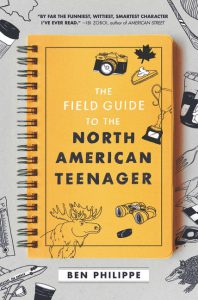Observable Qualities
Each chapter opens with field notes; Ben Phillippe’s protagonist reduces many of his observations to labels in order to make his world and the people in it easier to categorize and digest; readers can find themselves or their past social dilemmas in the pages of The Field Guide to the North American Teenager;
Key Subjects
- Norris Kaplan: the son of French Canadian Haitian parents, Judith and Felix; transplant from Montreal to Austin, Texas; prone to snarky, spiteful, and other satirical remarks; to some people, he’s the “dickish Canadian guy with a chip on his shoulder” (136) because he focuses on other people’s insecurities.
- Eric: Norris’ best friend and confidante in Canada who happens to be gay
- Aarti Puri, un-pin-down-able female subject of Norris’ interest, photographer focused on camera art, and future world conqueror
- Liam Hooper: Creative and sensitive young man with diverse interests who befriends Norris; he not only has a semicolon tattoo as a reminder that life goes on but teaches Norris important details about how to treat people, making Norris aware that he can be incredibly insensitive; an aggressively chill human being, according to Norris.
- Madison McElwees: kind, generous, and most interesting cheerleader in all of Texas; Norris’ mentor in the whispers and gossip and drama of high school politics; a peacekeeper, good sister, and obedient daughter who dedicates herself to making all the lives around her easier; the only one, according to Norris, who “had to be in the middle of the pyramid because she was the only one that could hold it all together” (137).
Lessons
- Although Norris initially hates Anderson High School, the city of Austin, and the state of Texas, he comes to realize that he has to take ownership of some of his discontentment. He also proclaims to hate “his dad for being all-around shitty, his mom for being selfish and well-adjusted . . . , [and the] special sun-freckled breed of assholes” (65) who attend his school. Maddie explains to Norris: “You can’t always see people well through other’s eyes, Canada. Who they are when there are other people around isn’t who they are when they’re alone” (135).
- When you’re the child of immigrants, your life is not entirely your own because your success is also that of your parents and cousins and relatives still struggling for life in another country. It is your “preordained celestial existence” to make the most of life and its opportunities.
- Some days are blissful and others are a bucket of vomit.
- Drunkenness brings human assholery to the surface.
- One of the perils of texting is that in the blink of an eye, the word general can autocorrect to genital.
- The people who cause the most harm never really intend to.
- No one is normal; “we’re all just different flavors of fucked-up” (344), hiding the best as we can and just trying our hardest to make it through each day being who we are. After all, “happy endings are artificial things manufactured out of less-than-ideal circumstances” (367); in fact, endings are endings only if we decide to make them so; “otherwise, things just added up and continued forward, across the map, in new shapes and iterations” (367).
- From Norris’ example, readers might think about the labels and names we assign to people, places, and things. When we categorize people, these labels put them into boxes, and no matter what they do or say, our psychological schemata won’t let them out of that box. The label defines them. Instead of seeking to understand any differences, we might use the differences to put a wall around the person. We don’t objectively look at their behavior or their value set and try to understand it; we just make our summary statement and place that person in their box. Interrogation of our labels and our labelling practices, as well as exposure to increase awareness, might open our minds so that we can also open the boxes in which we’ve trapped ourselves or others. Leaping out of our boxes and chewing up our labels may lead to new discovery.
Corollary Emotions
Humorous, reminiscent, and nostalgic
- Posted by Donna


